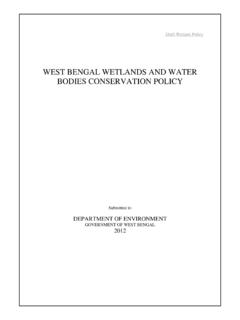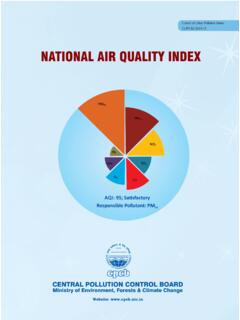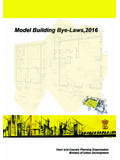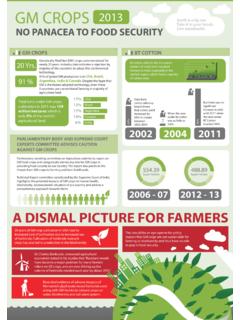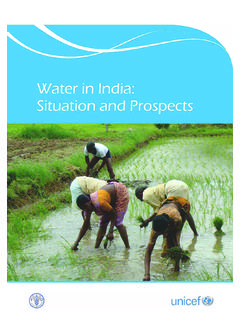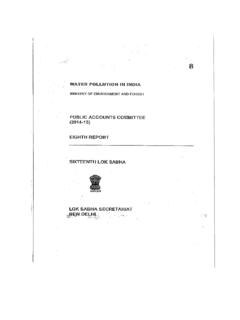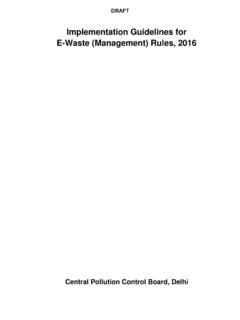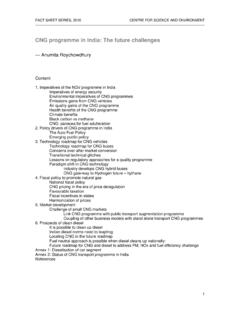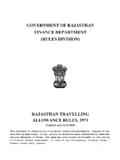Transcription of Government of Rajasthan - India Environment Portal
1 1 Government of Rajasthan Urban Development, Housing & LSG Department No. F10 (25) UDH/3/2011 Jaipur Dated Notification Subject: Rajasthan Slum Development Policy under Public-Private Partnership Model-2012.( Revised) 1. BACKGROUND Government of India have recently announced Rajiv Awas Yojana under which every citizen is to be provided access to basic civic and social services and decent shelter. Under this Policy, 50% of the cost of providing basic civic and social infrastructure and amenities and of housing including rental housing, transit housing for in-situ redevelopment of slums would we borne by the Government of India including O&M of assets created under the scheme. Public - Private Partnership has also been allowed under the scheme. 2. APPROACH Following is the multi-pronged approach of RAY: i.
2 Bringing all existing slums, notified or non-notified within the formal system and enabling them to avail of the same level of basic amenities as the rest of the town; ii. Redressing the failures of the formal system that lie behind the creation of slums; and iii. Tackling the shortages of urban land and housing that keep shelter out of reach of the urban poor and force them to resort to extra-legal solutions in a bid to retain their sources of livelihood and employment. Thus, the main focus of RAY is an integrated approach aimed at bringing within the formal system those who are forced to live in extra-formal spaces and in denial of right to services and amenities available to those with legal title to city spaces, and at correcting the deficiencies of the formal system of urban development and town planning that have failed to create conditions of inclusiveness and equity; s that, henceforth, new urban families, whether by way of migration or natural growth of population, have recourse to housing with municipal services, and are not forced to create encroachments and slums and live extralegal lives in conditions of deprivation of rights and amenities.
3 2 3. COVERAGE The scheme would be initially implemented in Class-I towns of the State. List of such towns as Annexure - I 4. IMPLEMENTATION APPROACH & STRATEGY UNDER RAY: (i) Under the provisions of Rajiv Awas Yojana for Identification of Slums a whole city approach would be taken, to map all the slums, notified as well as non-notified, and all unauthorized colonies unserved by municipal services. In each city, a total slum survey would be carried out, with biometric identification, to identify each slum dweller (resident, rather than owner of the shanty) for purposes of conferment of rights. Identification would be made of slums that can be upgraded holistically on site, with or without enabling changes in land use and FAR; and those which are untenable and have to be relocated.
4 With a whole city approach, vacant land inventory would be made. A citywide plan would be made to shift untenable slums to the nearest possible available vacant land or notified slum which has the space to receive them. Such slum mapping would also include mapping of the ownership categories of the encroached land viz. municipal, state, central Government , public sector undertaking and private in order to find or work out solutions for regularization and reconstruction suitable to each ownership category, ensuring land use modification, additional FAR wherever infrastructure permits etc., to create virtual space and provide incentives. The whole city approach would ensure that no slum is left out of the process of reconstruction and rehabilitation, either in situ or by relocation to another appropriate site.
5 (ii) In each slum, an integrated approach will be taken, with provision of infrastructure, basic civic and social amenities and decent housing, with attention to planning the layout (after reconfiguration of plots, if possible), total sanitation (with provision of individual toilets and water supply to each household) and provision of adequate green spaces as per (modified, if necessary) town planning norms. (iii) In-situ development will be encouraged as the programme of choice, to ensure that development does not lead to a loss of job, linkage of additional hours and income lost on commuting to work; where relocated, there will be emphasis on active intervention to provide mobility or recreating livelihood linkages. Transit housing to cyclically accommodate the temporarily displaced slum dwellers living in slums where phased in situ development is taken up, will be permissible.
6 (iv) The strategy for implementation of RAY proposes an open architecture with sufficient flexibility to the States and ULBs to decide their pace of implementation and models for arranging land, resources, housing, and partnerships, with the incentive of central support attached to the condition that they proceed systematically, with careful preparation, and commit to creating the conditions for inclusive urban growth. (v) In each slum, an integrated approach will be taken, with provision of infrastructure, basic civic and social amenities and decent housing, with attention to 3 planning the layout (after reconfiguration of plots, if possible), total sanitation (with provision of individual toilets and water supply to each household) and provision of adequate green spaces as per (modified, if necessary) town planning norms.
7 (vi) Community is to be involved at every stage, from planning through implementation to post-project sustenance stages. (vii) Private sector participation has been emphasized under RAY, for slum redevelopment, wherever feasible, as well as for creation of new affordable housing stock, both for rental and ownership, through imaginative use of land use and other concessions. (viii) The benefits of health, education, social security, workers' welfare, livelihood and public transport linkages for holistic slum redevelopment will be provided through conscious effort for convergence of schemes and dovetailing of budgetary provisions available under the programmes in the respective sectors. (ix) In regard to housing, full flexibility has been made available to the State/UT as to the manner of construction and arrangement of funds for construction viz.
8 To follow a beneficiary-built housing model, individually or in the case of multi-storied housing by housing associations, with design and technical support from the Municipality/ State, or construction of housing through State parastatals or private partners or by the option of Rental or Rental-to-Ownership housing or by delineating a mix of methods. The Plan of Action (PoA) would be required to give the description of the redevelopment model proposed to be followed in each slum, the efforts for obtaining the community's participation and the financial strategy for holistic development along with timelines. (x) The minimum size of housing unit on ownership basis would continue to be as settled under JNNURM, 25 sq mtrs carpet area, including, two rooms, balcony, a water-sealed toilet, bathroom, individual potable water connection, and space for a kitchen.
9 (xi) The PoA will need to delineate the financial strategy for holistic development. The financial strategy may require that the state put in place measures to secure credit from banks and housing finance institutions for the slum dwellers to contribute towards constructing their houses, including necessary assurances to reduce risk of capital lent, such as, for example, a Rajiv Awas Shelter Fund, to be used inter alia (i) to keep the slum/urban poor beneficiary from turning defaulter due to unemployment, death or other genuine distress and thereby risk forfeiture of dwelling unit and fore-closure on loan; and (ii) to share the lender's costs of servicing the loan. It has also been stipulated that the State may also consider creating, or enabling, in each slum or city, an Intermediating agency between the lender the borrower, which may be a Rajiv Awas Yojana Residents Housing Association of the slum dwellers, or such a housing association in collaboration with a micro- finance agency or a joint venture 4 between a municipal or State Housing Board, which will take care of tracking each borrower, and ensuring repayment.
10 In the event of intentional failure to pay the loan, this intermediating agency should also provide help to the lender to foreclose on the mortgage. 5. DEFINITION OF THE SLUM AREAS: The definition of slum would be as per the definition of the Sen Committee Report on Slum Statistics / Census "A slum is a compact settlement of at least 20 households with a collection of poorly built tenements, mostly of temporary nature, crowded together usually with inadequate sanitary and drinking water facilities in unhygienic conditions" for all States except the North Eastern and Special Category States. In these States compact settlements of 10-15 households having the same characteristics as above would be considered as slums. Where the Government or Local body is satisfied that: (a) Any area in the jurisdiction of the Urban Local Body which has already been declared and listed as a slum area.
